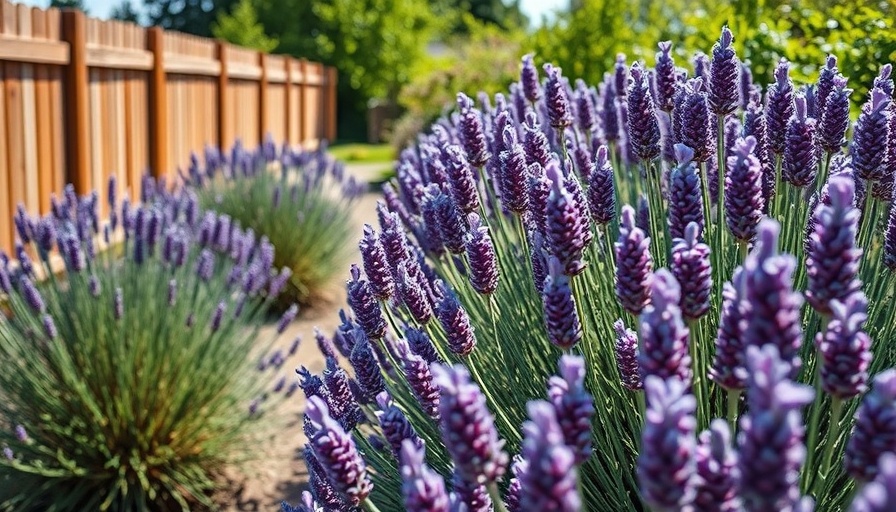
The Resilience of Drought-Tolerant Shrubs
In an age where climates are becoming increasingly unpredictable, growing a garden that withstands harsh conditions can seem daunting. For homeowners facing dry soil and relentless sunshine, the answer lies in embracing drought-tolerant shrubs. These hardy plants not only thrive under challenging circumstances but also enrich your garden's aesthetic appeal. Here’s a look at some of the best options available for your full-sun garden.
1. Lavender: The Aromatic Marvel
Lavender (Lavandula spp.) stands out as a champion among drought-tolerant shrubs. Known for its soothing scent and stunning purple blooms, it's a perennial favorite for good reason. Thriving in hot, dry conditions, lavender is ideal for those who want low-maintenance beauty. Beyond its ornamental appeal, it attracts beneficial pollinators like bees, enhancing the ecosystem of your garden. A perfect candidate for borders or gravel beds, once well-established, this shrub requires minimal watering.
2. Russian Sage: A Colorful Addition
Another excellent choice is Russian Sage (Perovskia atriplicifolia), characterized by airy stems and striking violet-blue blooms. This shrub excels in poor soil and tolerates neglect, making it a low-maintenance option. With its extended blooming season, Russian Sage can fill gaps in your landscape with ease while attracting a variety of pollinators.
3. Texas Sage: The Heat Survivor
Texas Sage (Leucophyllum frutescens) is magic in its own right. Bursting with blooms after a rain, its silvery foliage offers visual interest even when not in bloom. This evergreen shrub thrives in extreme heat yet remains fuss-free, making it an ideal choice for low hedges or as part of a vibrant landscape.
4. Butterfly Bush: Nature's Attractor
The Butterfly Bush (Buddleia davidii) is a must-have for those looking to invite wildlife into their gardens. Known for its fragrant flower spikes that bloom long into the summer, this shrub is not picky about soil and thrives in dry, sunny areas. Attracting both butterflies and bees, it adds an element of life and movement to any garden.
5. Crape Myrtle: A Summer Showstopper
The Crape Myrtle (Lagerstroemia indica) offers a dazzling array of colors and is another resilient choice. This shrub not only charms with its vibrant summer flowers but shows excellent drought resistance once established. Its ability to flourish through dry spells makes it a fantastic option for colorful garden displays without excessive care.
Choosing the Right Shrubs for Your Environment
When deciding on which drought-tolerant shrubs to include in your garden, consider factors such as local climate, soil type, and the amount of sun the area receives. For regions with extreme heat and low moisture, focusing on native plants can yield the best results as they are naturally adapted to those environmental conditions.
Benefits of Drought-Tolerant Plants
The shift towards planting drought-tolerant species, such as the ones mentioned above, is not just about aesthetics; it’s a sustainable practice that conserves water. In landscaping, these types of plants often require less maintenance and protective care, reducing the need for chemical fertilizers and unnecessary pesticides, promoting a healthier garden ecosystem. Moreover, their resilience makes them less susceptible to pests and diseases, leading to a more sustainable approach to gardening.
Looking Ahead: The Future of Gardening
As climate conditions evolve, the need for gardens that can withstand drought situations becomes imperative. Embracing these adaptations can create not just beautiful landscapes, but sustainable environments as well. The right combination of drought-tolerant shrubs can transform your outdoor space into a thriving ecosystem that balances form and function. With the rise in interest towards eco-friendly gardening, now is the perfect time to consider integrating these resilient shrubs into your garden.
Make the Switch to Drought-Tolerant Shrubs Today!
Incorporating drought-tolerant shrubs like lavender, Texas sage, and butterfly bush not only enhances your garden but also supports sustainable gardening practices. Take the first steps toward a resilient garden and explore these options for a more sustainable approach.
 Add Row
Add Row  Add
Add 




Write A Comment